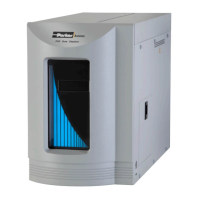
Do you have a question about the Parker Balston FID 1000 and is the answer not in the manual?
| Manufacturer | Parker Balston |
|---|---|
| Model | FID-1000 |
| Gas Type | Hydrogen, Air |
| Type | Flame Ionization Detector (FID) |
| Power Requirements | 115 VAC, 60 Hz or 220 VAC, 50 Hz |
| Dimensions | 22 in. H x 14 in. W x 18 in. D (55.9 cm x 35.6 cm x 45.7 cm) |
| Weight | 65 lb (29.5 kg) |
| Flow Rate | Up to 1 L/min for each gas |
| Outlet Pressure | Adjustable, up to 60 psig (4.1 bar) |
| Inlet Pressure | 80-100 psig (5.5 - 6.9 bar) |
| Purity | Hydrogen: <1 ppm total hydrocarbons; Zero Air: <1 ppm total hydrocarbons, <1 ppm CO, <25 ppm moisture; Makeup Gas: Determined by source gas purity |
Install indoors, protect from severe weather, dust, and dirt. Unit is free-standing.
Remove protective tape from ports and prepare the desiccant cartridge.
Set the voltage selector to match the local power supply for optimal performance.
Use deionized water with a resistivity of at least 5 Meg-Ohm/cm.
Requires clean air, free from oil, hydrocarbons, and particulates. Avoid chlorinated compounds.
Connect power, supply compressed air, turn on unit, and check display.
Designed for 24/7 operation; monitor hydrogen flow and water level.
Maintain water level, minimize piping dead-volume, avoid freezing and sudden demand.
Built-in monitoring alerts operator to faults with visual and audible alarms.
Check for leaks, demand exceeding capacity, or install flow control.
Check demand, piping, external leaks, or install flow control.
Check power, water level, shutoff valve, and for piping leaks.
Ensure adequate startup temperature and check zero air flow demand.
Replace the catalyst module every 2 years for optimal performance.
